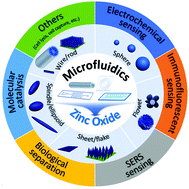当前位置:
X-MOL 学术
›
Biomater. Sci.
›
论文详情
Our official English website, www.x-mol.net, welcomes your feedback! (Note: you will need to create a separate account there.)
Microfluidics for ZnO micro-/nanomaterials development: rational design, controllable synthesis, and on-chip bioapplications.
Biomaterials Science ( IF 6.6 ) Pub Date : 2020/01/14 , DOI: 10.1039/c9bm01787a Nanjing Hao 1 , Michael Zhang 2 , John X J Zhang 1
Biomaterials Science ( IF 6.6 ) Pub Date : 2020/01/14 , DOI: 10.1039/c9bm01787a Nanjing Hao 1 , Michael Zhang 2 , John X J Zhang 1
Affiliation

|
Zinc oxide (ZnO) materials hold great promise in diverse applications due to their attractive physicochemical features. Recent years, especially the last decade, have witnessed considerable progress toward rational design and bioapplications of multiscale ZnO materials through microfluidic techniques. Design of a microfluidic device that allows for precise control over reaction conditions could not only yield ZnO particles with a fast production rate and high quality, but also permit downstream applications with desirable and superior performance. This review summarizes microfluidic approaches for the synthesis and applications of ZnO micro-/nanomaterials. In particular, we discuss the recent achievement of using microfluidic reactors in the controllable synthesis of ZnO structures (wire, rod, sphere, flower, sheet, flake, spindle, and ellipsoid), and highlight the unprecedented opportunities for applying them in biosensing, biological separation, and molecular catalysis applications through microfluidic chips. Finally, major challenges and potential opportunities are explored to guide future studies in this area.
中文翻译:

用于ZnO微/纳米材料开发的微流控:合理设计、可控合成和片上生物应用。
氧化锌 (ZnO) 材料由于其有吸引力的物理化学特性,在各种应用中具有广阔的前景。近年来,特别是过去十年,通过微流控技术在多尺度氧化锌材料的合理设计和生物应用方面取得了长足的进步。允许精确控制反应条件的微流体装置的设计不仅可以产生具有快速生产率和高质量的ZnO颗粒,而且还可以使下游应用具有理想和优越的性能。本综述总结了 ZnO 微/纳米材料的合成和应用的微流控方法。特别是,我们讨论了使用微流控反应器在 ZnO 结构(线、棒、球、花、片、片、纺锤形和椭球体)可控合成中的最新成就,并强调了将其应用于生物传感、生物通过微流控芯片进行分离和分子催化应用。最后,探讨了主要挑战和潜在机遇,以指导该领域的未来研究。
更新日期:2020-03-31
中文翻译:

用于ZnO微/纳米材料开发的微流控:合理设计、可控合成和片上生物应用。
氧化锌 (ZnO) 材料由于其有吸引力的物理化学特性,在各种应用中具有广阔的前景。近年来,特别是过去十年,通过微流控技术在多尺度氧化锌材料的合理设计和生物应用方面取得了长足的进步。允许精确控制反应条件的微流体装置的设计不仅可以产生具有快速生产率和高质量的ZnO颗粒,而且还可以使下游应用具有理想和优越的性能。本综述总结了 ZnO 微/纳米材料的合成和应用的微流控方法。特别是,我们讨论了使用微流控反应器在 ZnO 结构(线、棒、球、花、片、片、纺锤形和椭球体)可控合成中的最新成就,并强调了将其应用于生物传感、生物通过微流控芯片进行分离和分子催化应用。最后,探讨了主要挑战和潜在机遇,以指导该领域的未来研究。



























 京公网安备 11010802027423号
京公网安备 11010802027423号